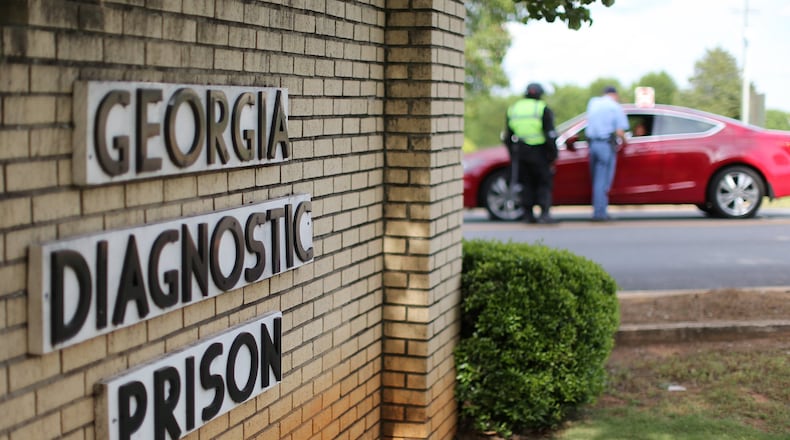Craig Haney, hired to assess conditions in the solitary confinement unit at the Georgia Diagnostic and Classification Prison, has visited some of the nation’s most dangerous prisons, but nothing could prepare him for what he witnessed on the E Wing.
The atmosphere was “as chaotic and out-of-control as any such unit I have seen in decades of conducting such evaluations,” he wrote. “When I entered this housing unit I was met with a cacophony of prisoner screams and cries for help. The noise was deafening and there was the smell of smoke in the air, as if someone had set a fire sometime earlier in the day.”
Such “Draconian”conditions at the Jackson prison’s special management unit, which houses up to 192 prisoners, have created some of the most “psychologically traumatized” inmates he’s ever assessed, Haney wrote in a blistering report, released this week in its entirety.
“They are at grave risk of harm,” he said. “That psychological harm may be irreversible and even fatal.
RELATED Second lawsuit against harsh solitary confinement unit
MORE: Inmate suicides rise; Is solitary confinement to blame?
A spokeswoman with the Department of Corrections declined comment, citing pending litigation.
Haney, a professor of psychology at the University of California, Santa Cruz, specializes in the psychological effects of imprisonment and consequences of solitary confinement. He was hired by the Southern Center for Human Rights, a leading advocate for criminal justice reform, after a prisoner filed a federal lawsuit claiming inhumane treatment within the GDC isolation unit. Similar suits from three other prisoners followed.
Credit: Craig Haney
Credit: Craig Haney
At every turn, the solitary unit — created to house the prison's most dangerous and destructive inmates — exceeds the deprivation seen in similar solitary or "Supermax" facilities, Haney said. They are deprived not only physical contract; verbal communication is virtually impossible, the report found. Even visual contact is fleeting, as prisoners are confined by solid metal doors instead of bars. Even the small "windows," on the cell doors, and in the rear of the cell, are covered by thick metal sheets.
Prisoners can’t see out; natural air and sunlight can’t seep in.
“The prisoners are in essence hermetically sealed inside their cells for the extended periods in which they are confined there,” Haney reported.
Conditions throughout the unit were “unusually severe,” said Haney. Prisoners are locked in their 7 x 13.5 feet cells for all but five hours a week, when they are allowed outside exercise time.
Those five hours are divided into two sessions and spent within a caged outdoor cell, paved with concrete and surrounded by institutional facilities — more industrial than natural, Haney notes.
“Dangerously” high level of mentally ill prisoners in isolation
Housing just one mentally ill prisoner within the solitary unit is problematic, Haney said.
At GDC, 70 of the 180 prisoners currently in isolation qualify as mentally ill.
“I do not believe there is any possible justification for housing such a high number of mentally ill prisoners in solitary confinement, especially not in a unit as harsh and severe as the Georgia SMU.”
And that’s not including prisoners in the unit who Haney, after reviewing the medical records of all 180 inmates, said exhibited serious mental problems. Two such prisoners committed suicide in 2017, he concludes. (Specifiic information about the prisoners is redacted.)
Credit: Craig Haney
Credit: Craig Haney
One, incarcerated since 2002, had an unstable childhood and was in need of mental help, his father wrote on a social history questionnaire. A mental health referral form from 2009 stated the prisoner had reported hearing voices for more than a year and had a history of treatment for anxiety, depression and multiple personalities. In 2015, he was moved to the special management unit.
He eventually hung himself with a sheet tied to a lighting fixture. His body was “stiff and cold … suggesting that officers had not checked on him in some time,” Haney wrote.
Prisoners with such pre-existing conditions “are likely to suffer greatly and deteriorate badly in solitary confinement,” the report states. “When their suffering and deterioration is ignored and they are retained in theses dangerously harsh and deprived conditions, the consequences can be fatal.”
The solitary trap
The isolation unit is supposed to operate within an incentive system; getting out is dependent on the prisoners’ behavior.
But Haney’s report found that malfunctions in the Tier III program used at GDC are often just as responsible for keeping prisoners in solitary for exceedingly long periods. The requirements for advancement out of the unit are often unrealistic and dispensed arbitrarily, Haney said.
A lack of bed space is another persistent problem, according to the report. The unit’s chief of security, Dwain Williams, corroborated this in a deposition, testifying that prisoners are often held in more restrictive quarters because they can’t find room elsewhere.
“Thus, prisoners often languish at the lowest and most deprived level in the system (and the levels at which they are at most risk of harm) not because of their behavior but because the prison cannot house them where they are supposed to be,” Haney wrote.
Prisoners told Haney they often did not know what they needed to do to advance out of solitary confinement.
“I’ve been here almost two years,” said one prisoner, whose name was redacted. “I don’t know how to get out. It’s supposed to be a six-month program but nobody has a release date. You only have a start date.”
Typically prisoners spend a staggering three to four years in isolation at GDC; nearly 20 percent of the inmates had been retained for six years or more.
Haney said since 2010 it’s become increasingly difficult to win transfer out of solitary.
“Instead, once there, it looks as if prisoners are hard-pressed to secure their release,” he said.
Nowhere is it worse than the E Wing, the most restrictive portion of the special management unit. Most suffer from poor mental health.
Prisoners told Haney they are kept in their cells virtually around the clock, for weeks or months on end.
“We never get out of our cells,” one prisoner said. “We are caged in. They don’t even want to take us to shower.”
Haney described a palpable sense of hopelessness pervading through the E wing.
“We are just desperate, so we yell and scream for help,” another prisoner told him. They ignore us or they beat us up.”
The report detailed four cases in which prisoners were battling serious mental health issues.
“Each man reported suffering greatly in this environment and manifested symptoms associated with psychological trauma and stress and the psychopathological effects of isolation,” Haney wrote. “None appear to have received the kind of in-depth mental health treatment that their serious psychiatric histories and conditions appeared to require.”
About the Author
Keep Reading
The Latest
Featured





